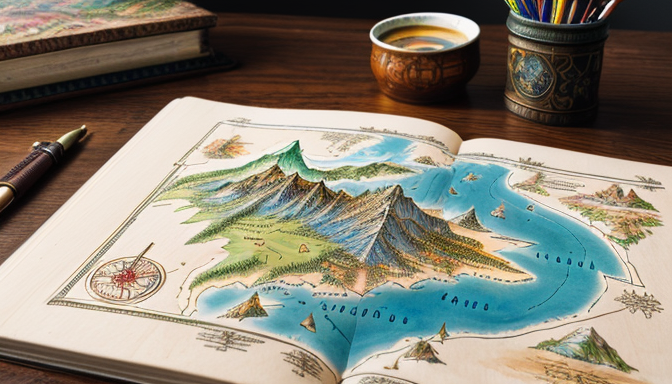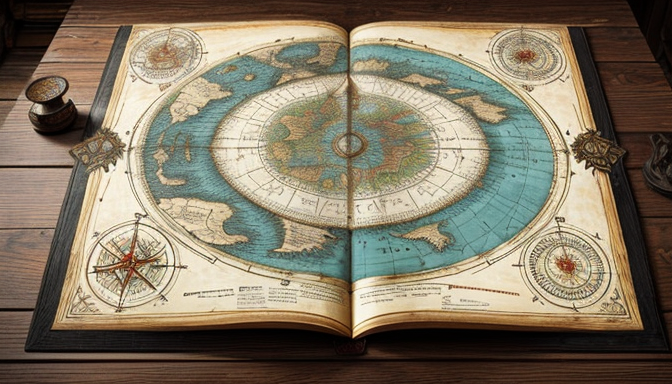Have you ever found yourself lost in the pages of a book, your mind wandering through fantastical landscapes and mythical realms? Fictional maps play a crucial role in this journey, acting as gateways to worlds we can only dream of. They are not just illustrations; they are blueprints of imagination, guiding us through the intricate web of stories crafted by authors and creators. These maps often depict mountains, rivers, and kingdom borders, each element meticulously designed to enhance the narrative experience.
Take a moment to consider how a well-crafted map can transform a story. It allows readers to visualize the vastness of a realm, understand the challenges characters face, and appreciate the geography of adventure. For instance, in the world of J.R.R. Tolkien’s Middle-earth, the map is not merely a backdrop; it is a character in its own right, influencing the journey of Frodo and his companions. The landforms and locations on the map are pivotal in shaping their quest, making the journey feel real and tangible.
Moreover, creating these maps isn’t just a task for seasoned authors; it’s a powerful exercise for anyone looking to enhance their storytelling skills. By sketching out realms and borders, writers can explore new ideas and push the limits of their creativity. So, why not grab a pencil and let your imagination run wild? Who knows what uncharted territories you might discover!
The Role of Maps in Storytelling
Maps are not just visual aids; they are the very lifeblood of storytelling that breathe life into fictional worlds. Imagine diving into a novel or a game where the characters traverse through vast kingdoms, treacherous mountains, and enchanted forests. How can we truly appreciate their journey without a map to guide us? A well-crafted map serves as a portal that invites us to explore the intricacies of a realm, making the experience more immersive and engaging.
When we look at a map, we can almost feel the pulse of the story. It highlights critical landforms, such as towering mountains, winding rivers, and sprawling cities, which are essential for understanding the characters’ challenges and achievements. For instance, consider how the borders of a kingdom can symbolize conflict, power struggles, and alliances. Each line drawn on a map tells a story of its own, revealing secrets that only the most observant readers can uncover.
Furthermore, maps can enhance our understanding of character arcs and their journeys. They help us visualize where characters start, the obstacles they face, and their ultimate destinations. This visual representation can evoke emotions and create a deeper connection with the narrative. In essence, a map is not just a tool; it’s a canvas for our imagination, allowing us to wander through realms that exist only in our minds.
So, the next time you pick up a book or start a new game, take a moment to appreciate the map. It’s more than just lines and shapes; it’s a gateway to adventure!

Cultivating Creativity Through Cartography
Have you ever wondered how a simple map can unlock the doors to entire universes? When it comes to creating fictional worlds, cartography is not just about drawing lines and shapes; it’s about breathing life into the very essence of a story. A well-designed map can ignite the imagination, transporting readers and players to realms filled with adventure, mystery, and endless possibilities.
By crafting maps, writers and artists delve into the intricacies of their worlds. They consider various elements such as landforms, climates, and even the cultures that inhabit these spaces. This process not only enhances the narrative but also enriches the creative journey. For instance, think about the sprawling landscapes of Middle-earth or the intricate kingdoms of Westeros. Each map tells a story of its own, highlighting the geography that shapes the characters’ lives and decisions.
Moreover, designing a fantasy map allows creators to analyze and define kingdom borders, which can lead to fascinating political dynamics and conflicts. Here’s a quick look at how mapping can influence storytelling:
| Element | Impact on Storytelling |
|---|---|
| Landforms | Influence character journeys and challenges. |
| Kingdom Borders | Define cultural interactions and conflicts. |
| Climate | Affect character survival and lifestyle choices. |
In essence, cartography is a powerful tool that not only enhances the visual appeal of a story but also deepens the reader’s engagement. So, grab your pencil, map out your dreams, and let your imagination run wild!
Frequently Asked Questions
- What is the significance of fictional maps in storytelling?
Fictional maps are not just pretty pictures; they serve as vital tools that help readers navigate the intricate worlds created by authors. They enhance immersion, making the story feel more real and allowing us to visualize the characters’ journeys. Think of them as the GPS for our imagination!
- How can creating a fictional map boost creativity?
When you draw a fictional map, you’re essentially crafting a new universe. This process stimulates imaginative thinking and encourages writers and artists to explore uncharted territories in their narratives. It’s like opening a door to endless possibilities, where every twist and turn can lead to exciting new adventures!
- Are there any tips for designing a compelling fictional map?
Absolutely! Start by considering the geography: mountains, rivers, and forests can shape your story’s culture. Don’t forget to think about the history and lore of your world, as these elements can add depth. Lastly, keep it visually appealing—colors and symbols can bring your map to life, making it a work of art!

Recent Comments